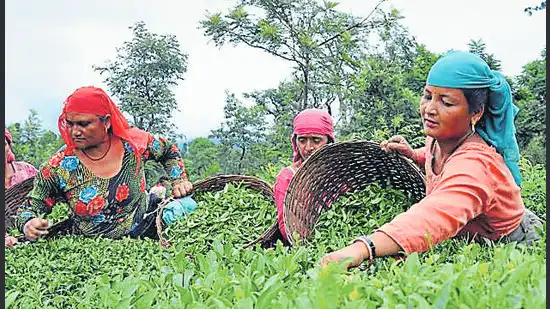Dry Winter Causes Trouble for Kangra Tea Production: Impact on Quality and Yield

Dry Winter Causes Trouble for Kangra Tea Production: Impact on Quality and Yield
Kangra tea, known for its unique flavor and delicate aroma, has long been celebrated as one of India’s finest teas. However, this year, the region’s tea farmers face unprecedented challenges due to a dry winter, which threatens the quality and yield of the much-loved tea. The combination of reduced rainfall and warmer temperatures harms the growth of tea leaves, leading to concerns about lower production and potential shifts in the tea’s flavor profile.
Impact of Dry Winter on Tea Plantations
Tea plantations in Kangra Valley, located in Himachal Pradesh, depend heavily on the weather conditions, particularly during the winter and spring seasons. Normally, the region experiences consistent rainfall, which ensures that the tea plants get enough water to grow and thrive. However, this dry winter disrupted the usual climatic patterns, leaving tea farmers worried about their crops.
The reduced rainfall during the winter months caused a significant drop in soil moisture levels, making it difficult for the tea plants to absorb enough water. Without sufficient water, the tea bushes struggle to produce the tender, new leaves essential for high-quality tea production. Experts believe that the prolonged dry conditions could result in smaller yields and lower-quality leaves, affecting the flavor and texture of Kangra tea.
Consequences for Tea Quality
Kangra tea is known for its distinct flavor, which results from the region’s unique combination of climate, altitude, and soil conditions. Tea enthusiasts appreciate the tea’s smooth, aromatic profile, which can range from floral and fruity to woody and earthy, depending on the specific variety. However, the dry winter has affected the overall quality of the leaves harvested this year.
Tea plants typically require a specific balance of temperature and moisture to produce the tender young shoots that contribute to the tea’s signature flavor. With water stress during the dry winter months, the plants produce older leaves that are less flavorful and less aromatic. These leaves may also be more prone to damage, which affects the overall quality of the final tea product.
Reduced Yields and Economic Impact
The reduced rainfall during the dry winter also led to a decline in the overall yield of Kangra tea. This poses a significant economic challenge for tea farmers in the region, as lower yields mean less tea to sell, directly affecting their income. Many farmers now grapple with the possibility of not being able to meet market demand, particularly with already strained global supply chains.
Kangra tea is not just a local commodity but also a valuable export product, with international buyers seeking it for its quality and unique taste. The region’s tea industry has been a significant source of income for thousands of families, providing jobs and supporting the local economy. However, the dry winter threatens to undermine these gains, leaving many in the industry anxious about the future.
Efforts to Combat Climate Change
The tea industry has long faced challenges from climate change, and the dry winter is one of the latest examples of how shifting weather patterns are affecting agricultural production. In recent years, tea farmers have had to adapt to the changing climate by implementing new farming techniques, such as rainwater harvesting, soil moisture conservation, and improved irrigation systems.
Additionally, the industry is focusing more on the need for sustainable farming practices to help mitigate the impact of extreme weather events. Some farmers in Kangra Valley are exploring the use of shade nets to protect the tea plants from the scorching sun and experimenting with different tea plant varieties more resistant to drought conditions.
The government and local tea organizations are also working to provide farmers with the resources and knowledge they need to cope with the challenges of climate change. Through workshops, funding, and research initiatives, they aim to ensure that the tea industry remains resilient in the face of unpredictable weather patterns.
Looking Ahead: The Future of Kangra Tea
Despite the challenges posed by the dry winter, experts suggest hope for the future of Kangra tea. A combination of adaptive farming practices, sustainable water management, and government support could help ensure that the region’s tea industry remains competitive and continues to produce high-quality tea for years to come.
Additionally, the increasing global demand for specialty teas presents an opportunity for Kangra tea producers to market their unique product as a premium offering. With the right investment in sustainable practices and infrastructure, Kangra tea could continue to thrive even in the face of climate challenges.
In the meantime, tea farmers in Kangra Valley remain resilient, hoping for more favorable weather conditions in the coming months. While the dry winter has caused considerable difficulty, it has sparked important conversations about the need for climate adaptation and sustainable agricultural practices in the tea industry.
For more information on how climate change is affecting agriculture in India and other regions, you can read more here.
Conclusion:
The dry winter in Kangra Valley has significantly impacted the tea industry, threatening both the quality and yield of Kangra tea. With reduced rainfall, the tea plants struggle to produce the tender leaves necessary for high-quality tea, and yields have been lower than expected. However, through sustainable farming practices and climate adaptation efforts, there is hope for the future of Kangra tea. The region’s tea farmers continue to navigate the challenges posed by a changing climate, working to protect their crops and ensure the continued success of this iconic tea.






